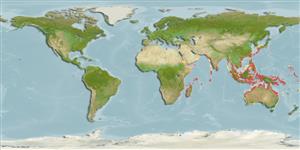>
Carangaria/misc (Various families in series Carangaria) >
Latidae (Lates perches)
Etymology: Psammoperca: Greek, psammos = sand + Greek,perke = perch (Ref. 45335).
More on author: Cuvier.
Environment: milieu / climate zone / depth range / distribution range
Écologie
marin; saumâtre récifal; profondeur 3 - 12 m (Ref. 90102). Tropical
Indo-West Pacific: Bay of Bengal, Indo-Australian Archipelago and northern Australia to the Philippines, China Sea and Japan (Ref. 2334). Found in the Mekong delta (Ref. 12693).
Length at first maturity / Taille / Poids / Âge
Maturity: Lm ?, range 28 - ? cm
Max length : 47.0 cm TL mâle / non sexé; (Ref. 2334); common length : 25.0 cm TL mâle / non sexé; (Ref. 9799)
Épines dorsales (Total): 8; Rayons mous dorsaux (Total): 12-14; Épines anales 3; Rayons mous anaux: 8; Vertèbres: 14. This species is distinguished from Psammoperca datnioides by the following set of characters: Colouration: when alive, the head and body brownish dark and often golden in colour; pored lateral-line scales yellow-edged; and similar yellowish brown colour in preserved specimens; lower counts of pored lateral line scales 46-48; hind margin of maxilla reaching slightly short of hind margin of eye when mouth closed; tiny scales that are not seen with naked eye, but visible through binocular scope, on the posterior uppermost part of maxilla; pelvic-fin spine subequal to 4th dorsal spine; circumpeduncular scale 21-22; moderately lesser body depth, 32-36% (mean 36%) of SL; lower counts, 5½ / 7½-9½ scale rows above and below lateral line; gill rakers 7 (including 6 rudiments) + 1 + 11 (including 3 rudiments) = 19 (9 rudiments); last dorsal-fin spine / penultimate dorsal-fin spine 1.5-1.7 (Ref. 124584).
Inhabits rocky or coral reefs, frequently in weedy areas, usually in holes and crevices by day. Enters estuaries (Ref. 4833). Forages on fishes and crustaceans at night (Ref. 9710). Mainly marketed fresh. In Hong Kong sold live in fish markets (Ref. 27253).
Life cycle and mating behavior
Maturité | Reproduction | Frai | Œufs | Fécondité | Larves
Iwatsuki, Y., S.J. Newman, F. Tanaka and B.C. Russell, 2018. Validity of Psammoperca datnioides Richardson 1848 and redescriptions of P. waigiensis Cuvier in Cuvier & Valenciennes 1828 and Hypopterus macropterus (Günther 1859) in the family Latidae (Perciformes) from the Indo-West Pacific. Zootaxa 4402(3):467-486. (Ref. 124584)
Statut dans la liste rouge de l'IUCN (Ref. 130435)
Menace pour l'homme
Harmless
Utilisations par l'homme
Pêcheries: commercial; pêche sportive: oui
Plus d'informations
RéférencesAquacultureProfil d'aquacultureSouchesGénétiqueElectrophoresesHéritabilitéPathologiesTraitementNutrientsMass conversion
CollaborateursImagesStamps, Coins Misc.SonsCiguateraVitesseType de nageSurface branchialeOtolithesCerveauxVision
Outils
Articles particuliers
Télécharger en XML
Sources Internet
Estimates based on models
Preferred temperature (Ref.
123201): 24.7 - 29.3, mean 28.4 °C (based on 2981 cells).
Phylogenetic diversity index (Ref.
82804): PD
50 = 1.0001 [Uniqueness, from 0.5 = low to 2.0 = high].
Bayesian length-weight: a=0.01047 (0.00484 - 0.02265), b=3.02 (2.83 - 3.21), in cm total length, based on LWR estimates for this (Sub)family-body shape (Ref.
93245).
Niveau trophique (Ref.
69278): 4.0 ±0.67 se; based on food items.
Résilience (Ref.
120179): Haut, temps minimum de doublement de population inférieur à 15 mois (Preliminary K or Fecundity.).
Fishing Vulnerability (Ref.
59153): Moderate vulnerability (37 of 100).
Nutrients (Ref.
124155): Calcium = 57.9 [28.1, 102.6] mg/100g; Iron = 0.579 [0.300, 1.063] mg/100g; Protein = 20 [18, 22] %; Omega3 = 0.14 [0.09, 0.21] g/100g; Selenium = 24.4 [13.5, 47.5] μg/100g; VitaminA = 62.7 [17.8, 226.9] μg/100g; Zinc = 1.19 [0.81, 1.83] mg/100g (wet weight);
